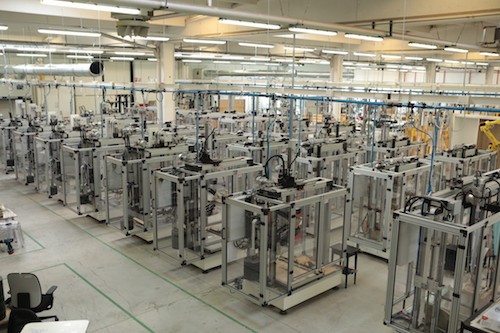 Industry 4.0
Industry 4.0 refers to the fourth industrial revolution where the creation of an
interconnected industrial environment ensures that IT systems (like manufacturing execution systems, planning/scheduling or product design software), robots, machines and operators are able to continuously exchange information with each other in order to optimize production as well as decisional and strategic processes. An interconnected environment is crucial for the emergence of the new digital asset represented by process data. Digitalization is in fact at the heart of the smart factory and real time connections are bound to produce relevant amounts of data over time. When properly stored and analyzed these data represent a source of fresh information that is potentially able to
enhance flexibility and efficiencyin daily operational practices.Within the furniture department at CATAS, that was completely renovated after the heavy fire of December 2016, the implementation of an interconnected architecture will be completed by
September 2018. It will involve about seventy robots/machines that will be uniquely identified within a dedicated network. This will allow to connect all of them to a server that will properly manage real-time process data. New functionalities (interfaces for remote interactions with robots and machines; smarter solutions for managing calibration and maintenance deadlines based on data; updates on the progress of specific tests; quick access to historical process data) will therefore rapidly become available for everybody within the department.
The main goals related to the implementation of an industrial environment that is compliant to the requirements of Industry 4.0 can be summarized as follows. First of all, the need of
optimizing productivity by means of continuous improvement practices based on data: this can be achieved by enhancing machine performances as well as by managing planning and scheduling of tests in a more effective way. Secondly, the possibility of
browsing and analyzing historical process data; in this respect, the
activation of specific sensors for measuring forces, positions, pressures or accelerations will give brand new numerical insights on undergoing tests.
The transformation of a test laboratory into a smart digital factory that is compliant to the standard of Industry 4.0 certainly represents an innovative scenario in the wood and furniture sector where the enhanced cooperation among all players (operators, IT systems and machines) can potentially bring to profoundly revised business models and approaches to the market.
For info:Martino Olivo
tel. +39 0432 747265
e-mail
olivo@catas.com

 Industry 4.0 refers to the fourth industrial revolution where the creation of an interconnected industrial environment ensures that IT systems (like manufacturing execution systems, planning/scheduling or product design software), robots, machines and operators are able to continuously exchange information with each other in order to optimize production as well as decisional and strategic processes. An interconnected environment is crucial for the emergence of the new digital asset represented by process data. Digitalization is in fact at the heart of the smart factory and real time connections are bound to produce relevant amounts of data over time. When properly stored and analyzed these data represent a source of fresh information that is potentially able to enhance flexibility and efficiencyin daily operational practices.
Industry 4.0 refers to the fourth industrial revolution where the creation of an interconnected industrial environment ensures that IT systems (like manufacturing execution systems, planning/scheduling or product design software), robots, machines and operators are able to continuously exchange information with each other in order to optimize production as well as decisional and strategic processes. An interconnected environment is crucial for the emergence of the new digital asset represented by process data. Digitalization is in fact at the heart of the smart factory and real time connections are bound to produce relevant amounts of data over time. When properly stored and analyzed these data represent a source of fresh information that is potentially able to enhance flexibility and efficiencyin daily operational practices.